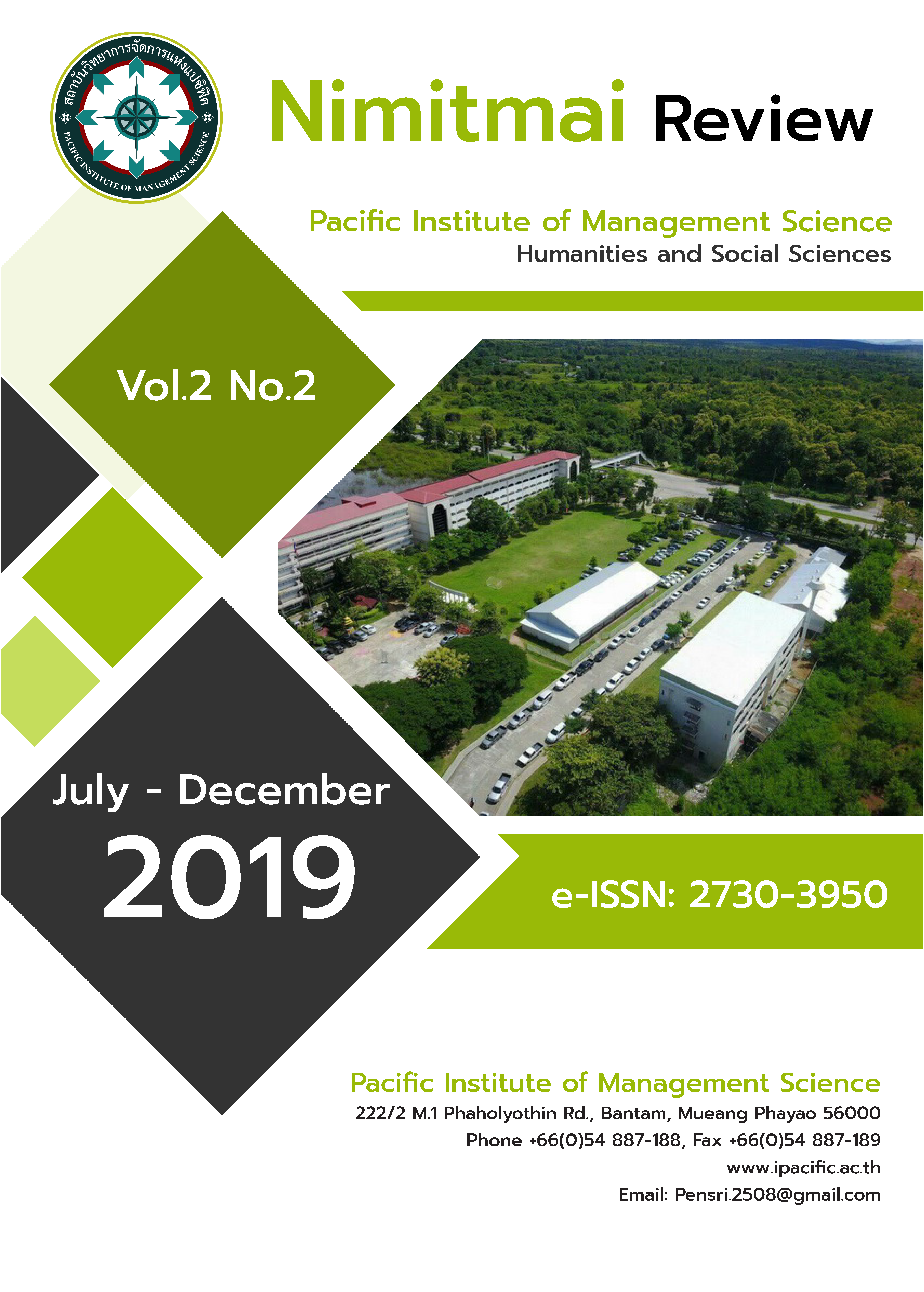Effects of Psychological Efficacy and Job Involvement toward the Job Performance of State Enterprise Bank Employees in Bangkok
Keywords:
Psychological Efficacy / Job Involvement / Job PerformanceAbstract
This study aimed to explore: (1) psychological efficacy, job involvement, and job performance; and (2) investigate job involvement as a mediated factor between psychological efficacies toward job performance of state enterprise bank employees in Bangkok. Samples of the study were 100 branch managers of state enterprise banks in Bangkok. Questionnaires were implemented as a research tool in this study, data were statistically analyzed by percentage, means, standard deviation, and structural equation model (SEM). Findings in the study revealed that: (1) the overall results of psychological efficacy, job involvement, and job performance of the employees were at a high level (=3.94, 3.72, and 3.60 respectively); and (2) the coefficient results (Boot LLCI) of the effect of job involvement as a mediated factor between psychological efficacy and job performance were at 0.308 and the Boot ULCI results were at 0.566. Therefore, this study ascertained that the outcomes of different studies could be established as the fundamental job performance, depending on the affective attitude and the job involvement of the employees to enhance the human relationship efficacy within the organizations
References
Arefin, S., Arif, I., & Raquib, M. (2015). The mediating role of psychological empowerment in the relationship between high-performance work systems and organizational citizenship behavior. European Scientific Journal, 11(2), 264-277.
Bank of Thailand. (2018). Financial institution. Retrieved September 11, 2018, from https:// www.bot.or.th/Thai/BOTStoryTelling/Pages/FinancialInstitutions_StoryTelling_FI.aspx.
Bank of Thailand. (2018). Specialized financial institutions: SFIs. Retrieved September 15, 2018, from https://www.1213.or.th/th/aboutfcc/finservices/Pages/SFIs.aspx.
Bouzarit, M., & Karatepe, O. M. (2016). Test of a mediation model of psychological capital among hotel salespeople. International Journal of Contemporary Hospitality Management, 29(8), 2178-2197.
Chen, T. J., Lin, C. C., & Wu, C. M. (2016). High-performance work system, psychological efficacy, job satisfaction and task performance in the Hotel Workplace. Open Journal of Social Sciences, 4, 76-81.
Hair, J. F., Hult, G. T. M., Ringle, C. M., & Sarstedt, M. (2017). A primer on partial least squares structural equation modeling (PLS-SEM). Thousand Oaks: Sage.
Husin, N. H., & Gugkang, A. S. (2017). High-performance work systems and employee job performance: Evidence from the banking sector in Malaysia. Journal of Global Business and Social Entrepreneurship, 1(3), 62-74.
Ibrahim, I. I., Githae, W., & Stephen, D. (2014). Indigenous contractor's involvement and performance in construction procurement systems in Nigeria. Global Journal of Researches in Engineering, 14(1), 4-16.
Jyoti, J., & Dev, M. (2016). Perceived high-performance work system and employee performance: Role of self-efficacy and learning orientation. Metamorphosis, 15(2), 115-133.
Kappagoda, S., Othman, H. Z. F., & Alwis, G. (2014). Psychological capital and job performance: The mediating role of work attitudes. Journal of Human Resource and Sustainability Studies, 2, 102-116.
Likert, R. A. (1932). A technique for the measurement of attitudes. Archives of Psychology,140, 5-53.
Luthans, F., Avolio, B. J., Avey, J. B., & Norman, S. M. (2007). Positive Psychological Capital: Measurement and Relationship with Performance and Satisfaction. Personnel Psychology, 60, 541-572.
Piriyakul, M. (2010). Partial Least Square Path Modeling (PLS Path Modeling). Bangkok: Ramkhamhaeng University.
Preacher, K. J. & Hayes, A. F. (2008). Asymptotic and resampling strategies for assessing and comparing indirect effects in multiple mediator models. Behavior Research Methods, 40, 879-891.
Rizwan, M., Khan, D. J., & Saboor, F. (2011). Relationship of job involvement with employee performance: Moderating role of attitude. European Journal of Business and Management, 3(8), 77-85.
Setar, S. B., Buitendach, J. H., & Kanengoni, H. (2015). The moderating role of psychological capital in the relationship between job stress and the outcomes of incivility and job involvement amongst call center employees. SA Journal of Industrial Psychology, 41(1), 1-13.
Shih, H. A., Chiang, Y. H., & Hsu, C. C. (2013). High-performance work system and HCN performance. Journal of Business Research, 66, 540-546.
Sofijanova, E., & Zabijakin-Chatleska, V. (2013). Employee involvement and organizational performance evidence from the manufacturing sector in the Republic of Macedonia. Trakia Journal of Sciences, 11(1), 31-36.
Sourchi, S. M. M., & Jianqiao, L. (2015). The positive impact of high-performance work systems (HPWS) on employee commitment and self-sufficiency in strategic human resource management (SHRM) in Kurdistan. European Journal of Business and Management, 7(3), 80-109.
State Enterprise Policy Office. (2018). State enterprise definition. Retrieved September 11, 2018, from http://www.sepo.go.th/content/12.



